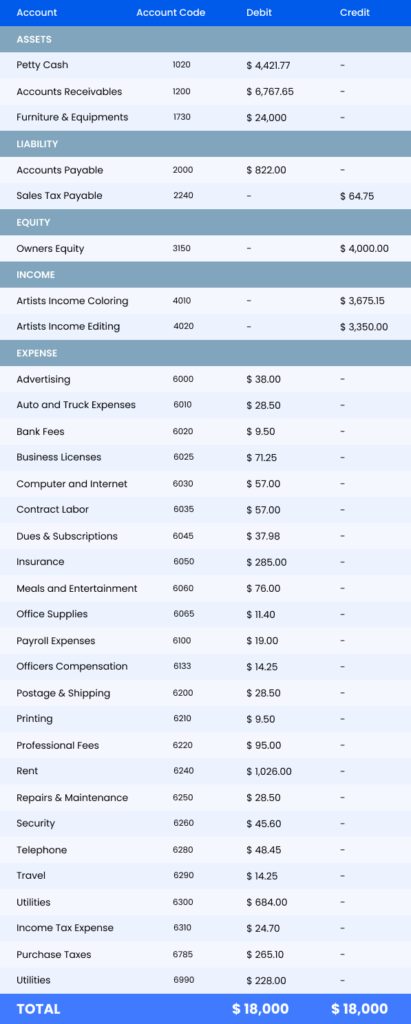Trial balance is an accounting reporting in which the balance of all accounting categories is calculated into debit and credit column totals. A correct trial balance should equal the credit and debt, if it doesn’t there are errors in the accounting transactions. Businesses usually prepare trial balance reports at end of every reporting period like monthly.
The purpose of using trial balance is to make sure that the company’s bookkeeping entry processes are mathematically correct.
How to prepare a trial balance report?

A trial balance is a point in time report, meaning it is only valid for the specific time on which the report is prepared. It can be prepared for a specific time, but not over a period of time. For example. You can prepare a trial balance as of Dec 31st but you cannot prepare it for the last year.
Once the report time point is identified, it is important to gather all the balances of every account or category in your accounting system. Usually assets, expense categories will have debit balance and liability, equity and income categories will have a credit balance. Usually, the trial balance will have 3 columns. Account or categories name followed by debit and credit column.
Should trial balance net to Zero?
The trial balance should always zero out, the sum of debits of all accounts must equal the sum of credit of all accounts. If the report doesn’t zero out, then there is mathematical or transactions errors for any of the accounting categories. Accountants usually run trial balance report to check for consistency of the accounting books.
A trial balance is a list of all that contain credit and debit balances, in the ledger accounts. If every double entry is carried correctly, the credit balances total should always be equal to the debit balances total in the trial balance. If there occurs an imbalance, then there is an error, or issue on the nominal ledger accounts.
Modern accounting software like QuickBooks, myBooks has the ability to generate trial balances with a click of a button at any point in time. Additionally, the use of accounting software usually enables systematically correct transactions free of mathematical errors and hence mostly it will zero out making sure the accounting system is free of mathematical errors.
Some of the instance trial balance errors

- You might repeat the entries twice
- You might have updated the entries to the incorrect account
- Omission of entries
- Mistake or error in moving the balances to the trial balance
- The incorrect cash amount is posted in the ledger
- Transposition error
- Mistake in balancing an account
- You may update the entry inaccurately i.e., an entry in the wrong column, credit instead of debit, and vice versa.
What are the types of trial balances?
There are 3 types of trial balance to help and support our business.
Types of trial balance:
- Adjusted trial balance
- Unadjusted trial balance
- Post-closing Trial Balance
Unadjusted Trial Balance
The trial balance report prepared with the help of the ledger entries. The unadjusted trial balance created before the journal entry adjustment. In simple terms, we can define it as the reflection of each day’s debits and credits.
This type is used when creating the adjusted trial balance.
Adjusted trial balance
This type of trial balance prepared once you complete the adjustment entries. It expresses your respective company accounts’ closing balance. It makes sure that the errors in the unadjusted trial balance are rectified and accurate.
Post-closing Trial Balance
This type of trial balance will post each and every balance in the balance sheets with the zero net balance. This particular type will verify that the credit and debit balances are identical. Additionally, this type will act as the starting trial balance for the upcoming financial year.
Trial balance items List:
The trial balance item lists for both credit and debit is as follows,
- The Trial Balance List Items from Credit Side
The credit side trial balance will feature entries from accounts such as, drawings accounts, assets, expense accounts, bank balance, cash balance, purchases, Loses, and sundry debtors, among others.
- The Trial Balance List Items from Debit Side
Debit side trail balance will feature entries from income accounts, capital accounts, liabilities, sundry creditors, sales, gains, and reserves.
Sample Trial Balance Report | Trial Balance Report Example
| Trial Balance Report | |||
| ACCOUNT | ACCT CODE | DEBIT | CREDIT |
| ASSETS | |||
| Petty Cash | 1020 | $ 4,421.77 | $ – |
| Accounts Receivable | 1200 | $ 6,767.65 | $ – |
| Furniture & Equipments | 1730 | $ 500.00 | $ – |
| LIABILITY | |||
| Accounts Payable | 2000 | $ 822.00 | $ – |
| Sales Tax Payable | 2240 | $ – | $ 648.75 |
| EQUITY | |||
| Owners Equity | 3150 | $ – | $ 4,000.00 |
| INCOME | |||
| Artists Income Coloring | 4010 | $ – | $ 3,675.15 |
| Artists Income Editing | 4020 | $ – | $ 3,350.00 |
| Artists Inc. Fine art comm. | 4030 | $ – | $ 6,250.00 |
| EXPENSE | |||
| Advertising | 6000 | $ 38.00 | $ – |
| Auto and Truck Expenses | 6010 | $ 28.50 | $ – |
| Bank Fees | 6020 | $ 9.50 | $ – |
| Business Licenses | 6025 | $ 71.25 | $ – |
| Computer and Internet | 6030 | $ 57.00 | $ – |
| Contract Labor | 6035 | $ 57.00 | $ – |
| Dues & Subscriptions | 6045 | $ 37.98 | $ – |
| Insurance | 6050 | $ 285.00 | $ – |
| Meals and Entertainment | 6060 | $ 76.00 | $ – |
| Office Supplies | 6065 | $ 11.40 | $ – |
| Payroll Expenses | 6100 | $ 19.00 | $ – |
| Officers Compensation | 6133 | $ 14.25 | $ – |
| Postage & Shipping | 6200 | $ 28.50 | $ – |
| Printing | 6210 | $ 9.50 | $ – |
| Professional Fees | 6220 | $ 95.00 | $ – |
| Rent | 6240 | $ 1,026.00 | $ – |
| Repairs & Maintenance | 6250 | $ 28.50 | $ – |
| Security | 6260 | $ 45.60 | $ – |
| Telephone | 6280 | $ 48.45 | $ – |
| Travel | 6290 | $ 14.25 | $ – |
| Utilities | 6300 | $ 684.00 | $ – |
| Income Tax Expense | 6310 | $ 24.70 | $ – |
| Purchase Taxes | 6785 | $ 265.10 | $ – |
| Utilities | 6990 | $ 228.00 | $ – |
| TOTAL | $17,923.90 | $17,923.90 | |
Sample Trial Balance Report | Infographic

FAQ's
What is the trial balance in accounting?
In accounting trial balance is nothing but a financial report, which displays the al accounts closing balance in the general ledger for the particular period. In closing books, making a trial balance is the first step at the accounting period end.
What are the types of trial balances?
There are 3 types of trial balance in accounting to support businesses.
Types of trial balance
- Post-closing Trial Balance
- Adjusted trial balance
- Unadjusted trial balance
What is the difference between a trial balance and a general ledger?
In accounting, the general ledger is defined as a book of accounts, whereas, the trial balance is a listing of the accounts and balances in each of the accounts in the general ledger.
Trial balance is used for monthly reviews and forecasting. On the other hand, a general ledger is used for loan applications, reporting financial data, and audits.
Why does a trial balance net to zero?
The trial balance should be net to zero and should be balanced — it is accomplished to review the debit and credit column totals on the general ledger accounts which match each other and assist you to spot any accounting errors if it holds. If the output finds a mismatch, then there is an error that should be sorted.
A trial balance will not balance if your business transaction isn’t entered in the right way for both a single debit and credit account.
How to correct a trial balance?
If you found a mismatch or error on the trial balance, you need to fix the trial balance error. It can be done by checking all your business transactions (Accounting transaction report) and general ledger.
What is the purpose of trial balance?
The main purpose of the trial balance is,
- To check the credit and debit equivalency in the general ledger
- To know and rectify the error on posting and vernalization
- With the trial balance, businesses will prepare financial statement
Related Article
Trial balance Vs. Balance sheet Vs. P&L Vs. Income statement
This article will get the clear-cut difference between the Trial balance Vs. Balance sheet Vs. Profit and loss Vs. Income statement. Read more.




